Mass is a result of a scalar field that exists at every point in space
Related:
This post attempts to explain what the Higgs Boson is - to do so requires a bit of backstory.
It attempts to summarize some of the most advanced theories very quickly, including quantum electrodynamics and flavor-dynamics, but not in great detail. Many of these sections will probably be broken up into full separate posts in the future.
Electromagnetic Field
For a very long time, electricity and magnetism were thought of as completely distinct forces. It wasn’t until James Clerk Maxwell unified them that we understand that there is only one field.
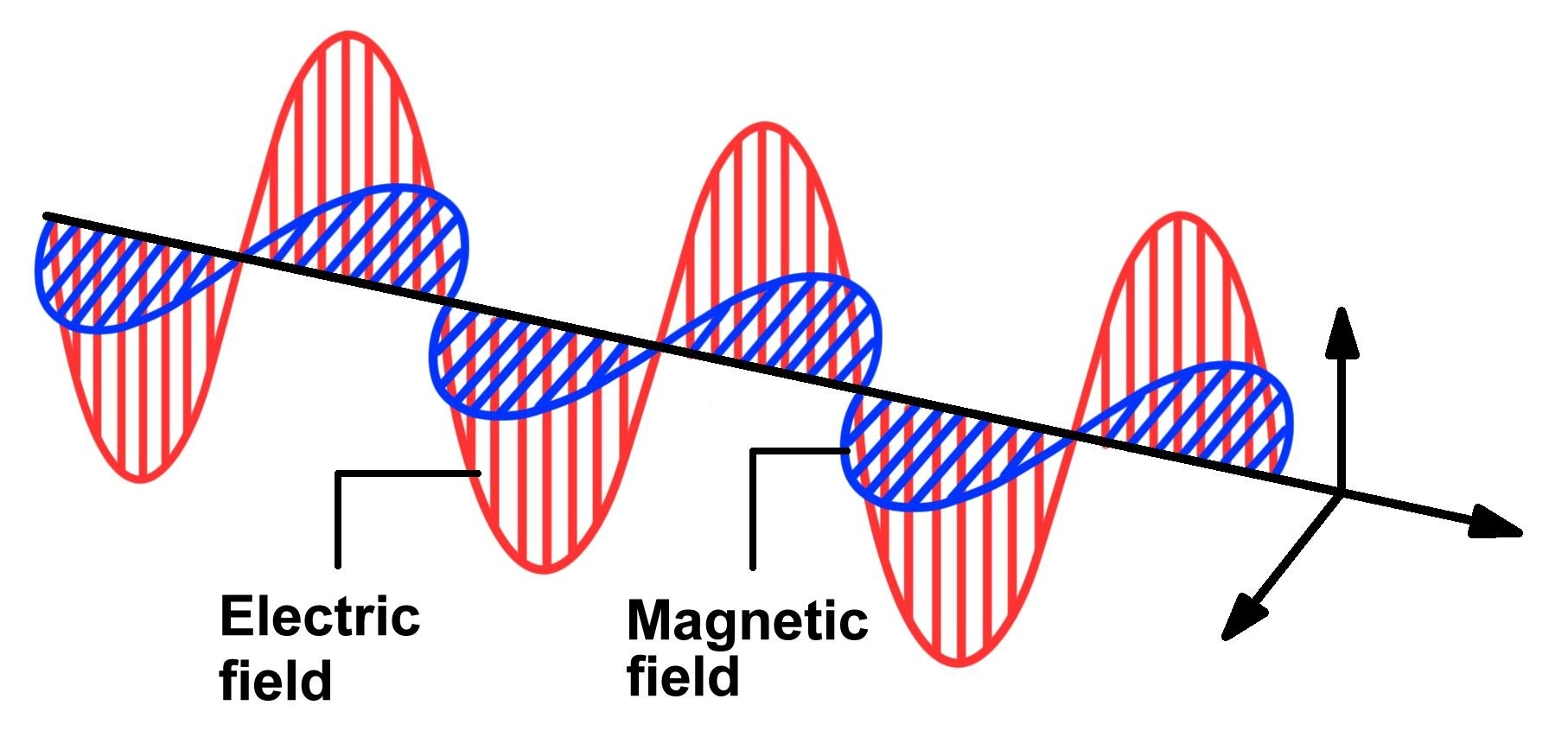
The Maxwell equations showed how a changing electric current creates a magnetic field, and that they together act as waves that could travel through space. He also showed that light itself is this electromagnetic wave.
The two forces appeared different only because they oscillate perpendicular to each other, but are one in the same.
Photo-Electric Effect
After the unification of the electric and magnetic fields, Einstein made a crucial discovery - the photoelectric effect. Interestingly, this is what won him the Nobel Prize, not his work in relativity.
The effect describes the property of when electrons are emitted when light hits a material.
In 1905 Einstein was the one who proposed that light doesn’t act as a wave, but as discrete packets of energy called photons.
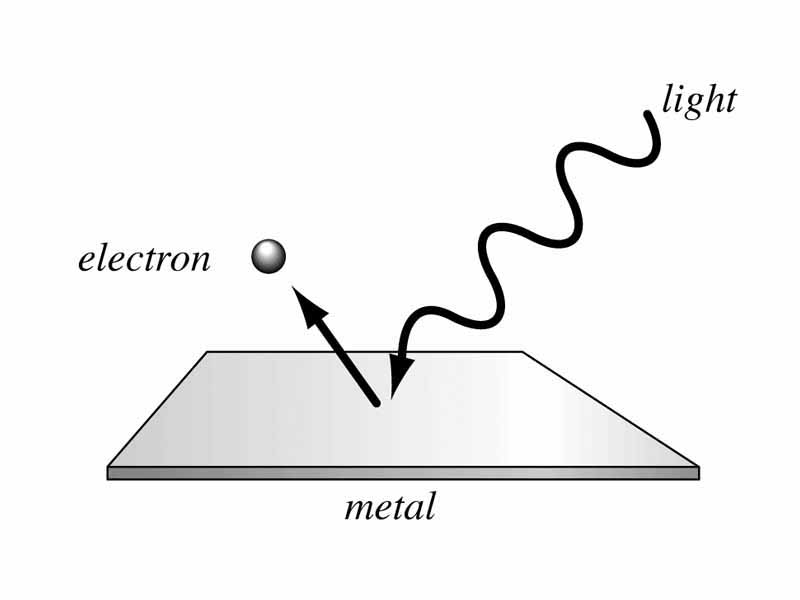 A key principle is the threshold frequency - the emission of photoelectrons only occurs when the light is above a minimum frequency. Each material has a minimum energy required to release an electron - known as the Work Function (ϕ).
A key principle is the threshold frequency - the emission of photoelectrons only occurs when the light is above a minimum frequency. Each material has a minimum energy required to release an electron - known as the Work Function (ϕ).
The kinetic energy of a photon is related only to the frequency of light, not the intensity, resulting in the famous energy equivalence:
E = hf
where h is the plank constant.
And so hf must be larger than the work function (ϕ) to eject an electron. One photon interacts directly with one electron, and excess energy is converted into the kinetic energy of the electron.
This theory is significant to quantum mechanics as it first demonstrates the wave-particle duality - how quantum objects behave as both distinct particles and general wave functions.
Quantum Electrodynamics
QED describes the way the light and matter interact in the quantum world. Instead of thinking of an electron as a simple particle, we must consider it to be constantly fluctuating and interacting with the quantum vacuum by emitting and reabsorbing virtual photons.
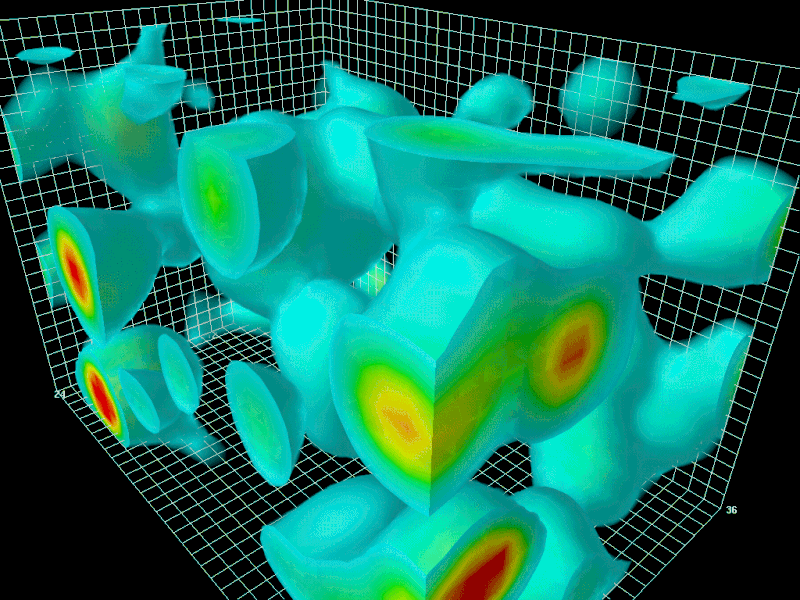
Renormalization
The issue with this approach is runaway infinities - basically because the electron is now self-interacting with these fluctuations, it leads to all sorts of infinities and infinite regressions.
A process called renormalization is applied to absorb for these self-interactions into a physical parameter. If this sounds confusing - it is - I’m not sure I can properly explain it without an extreme amount of math.
But this approach has be experimentally confirmed to be accurate, and QED has been very successful in predicting quantum behavior.
Weak Force
The photon itself is a boson, an elementary particle that is exchanged by fermions to carry a force.
There is another peculiar phenomenon that caught physicists attention - radioactive decay.
Carbon dating operates on the principle of a carbon-14 atom (8 neutrons and 6 protons) converting into a nitrogen atom (7 neutrons and 7 protons).
The decay occurs at a specific interval - where half the atoms decay in a certain time, known as the half life, allowing us to know the age of an object by the proportion of decayed carbon-14 atoms.
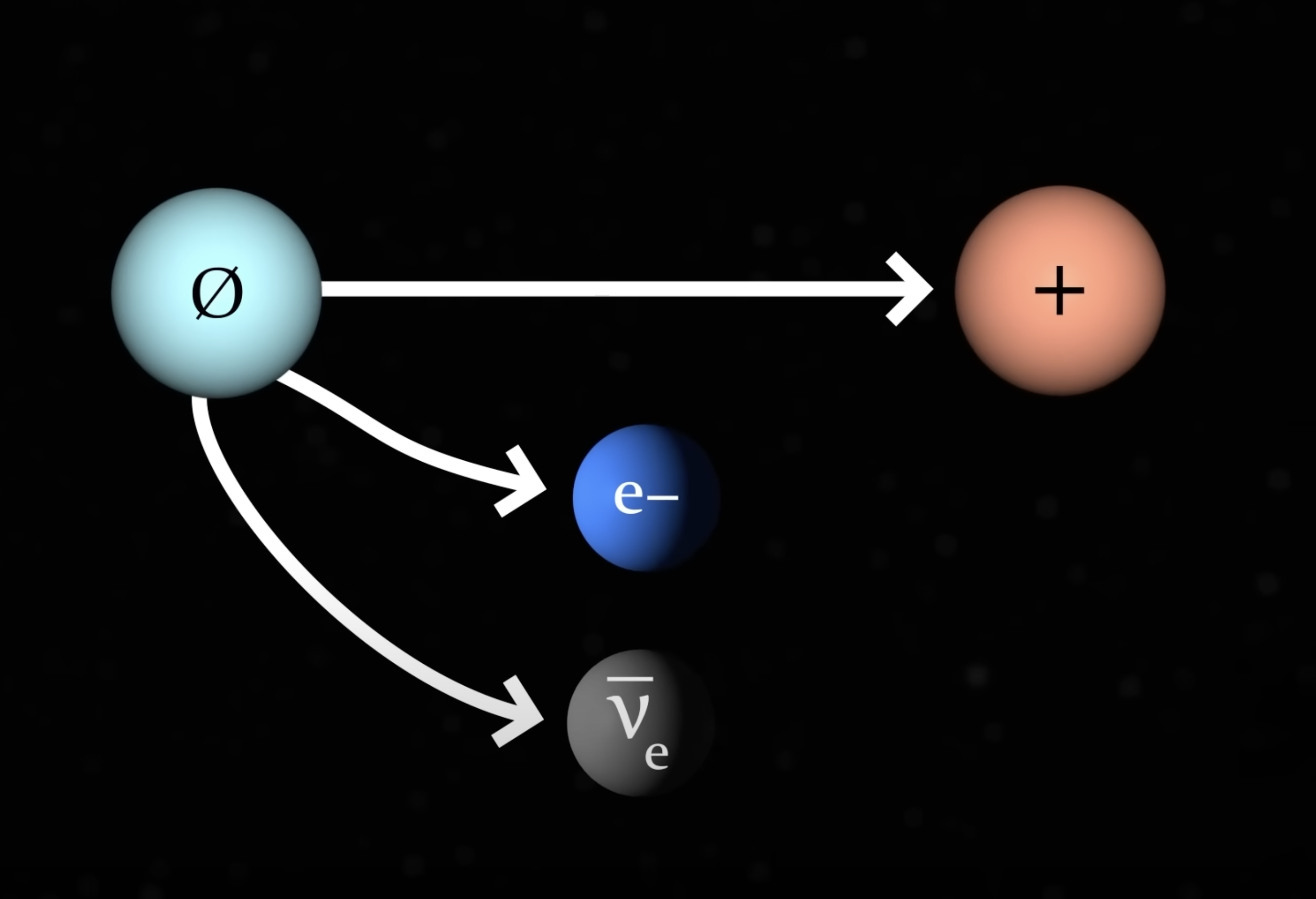
This occurs by the neutron emitting an electron and an electron-antineutrino. This process is called beta- decay, operated by the weak force - carried by Z and W bosons. (It can also happen the other way round, emitting a positron, called beta+ decay)
The important thing to understand is that the weak force can change an particle’s electric charge. This means the weak force must have at least 2 bosons - one to change to positive and one to negative - these are the W+ and W- bosons.
But the weak force can operate without changing the the charge, so there must also be a third - the Z boson, for zero.
These three bosons possess something very strange - mass.
The weak force is called weak not because it isn’t powerful, but because the virtual bosons last for such a short period of time and act over such a small distance.
Lifetime of Weak Bosons
It is unbelievably short, so much so that due to the energy mass equivalence, the bosons must be over 80 times more massive than a proton.
The W bosons exists for 0.0000000000000000000000003 seconds
To put this in perspective, there has been less seconds since the beginning of the universe, than W bosons lifespans could exist in a single second.
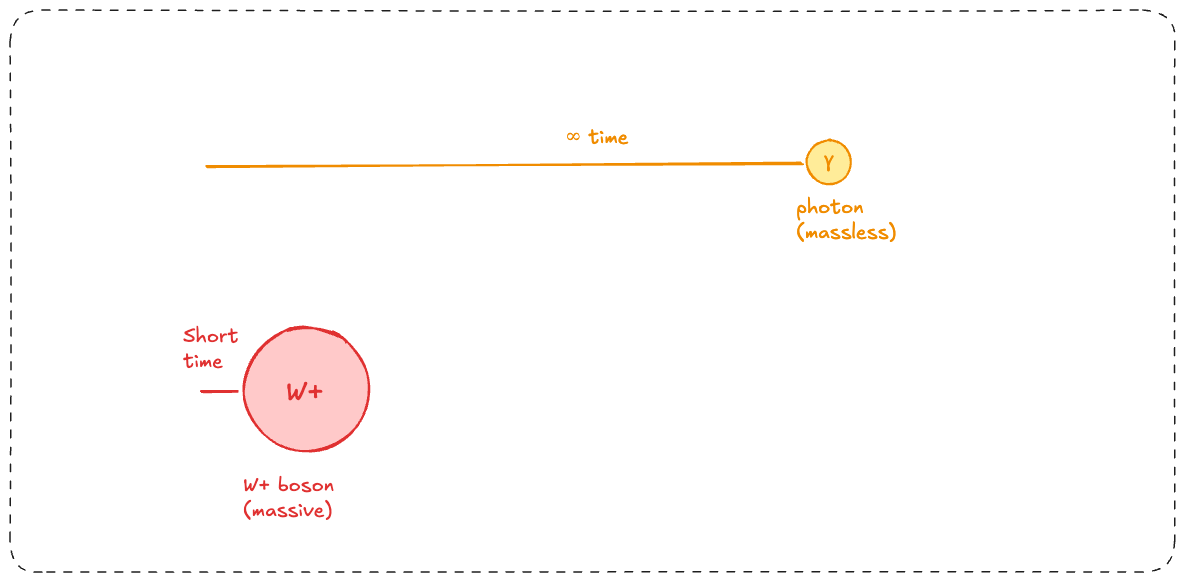
Remember that due to the x Heisenberg Uncertainty Principle, quantum fluctuations exist by “borrowing” energy from the field - they can either borrow a little for a long time, or a lot for a short time.
The infinity Problem
Without diving too deep into specifics, the weak force bosons cannot be renormalized like in QED.
Because of “point-like interactions”, basically when four different fermions need to be at the exact same point in spacetime for a weak force interaction to occur, we run into infinities occurring that can’t be absorbed in renormalization.
Each new order of calculation would just result in new infinities emerging. These infinities are found in the momentum of the virtual particles.
Electroweak Field
Instead of renormalization - the extreme mass of the weak bosons can “tame” the infinities.
- At low energies, they behave in point-like ways.
- At high energies, they smooth out the uncontrolled growth, and prevents it from exceeding physical limits.
Once more, just like the electromagnetic field, a further condensing forces was devised.
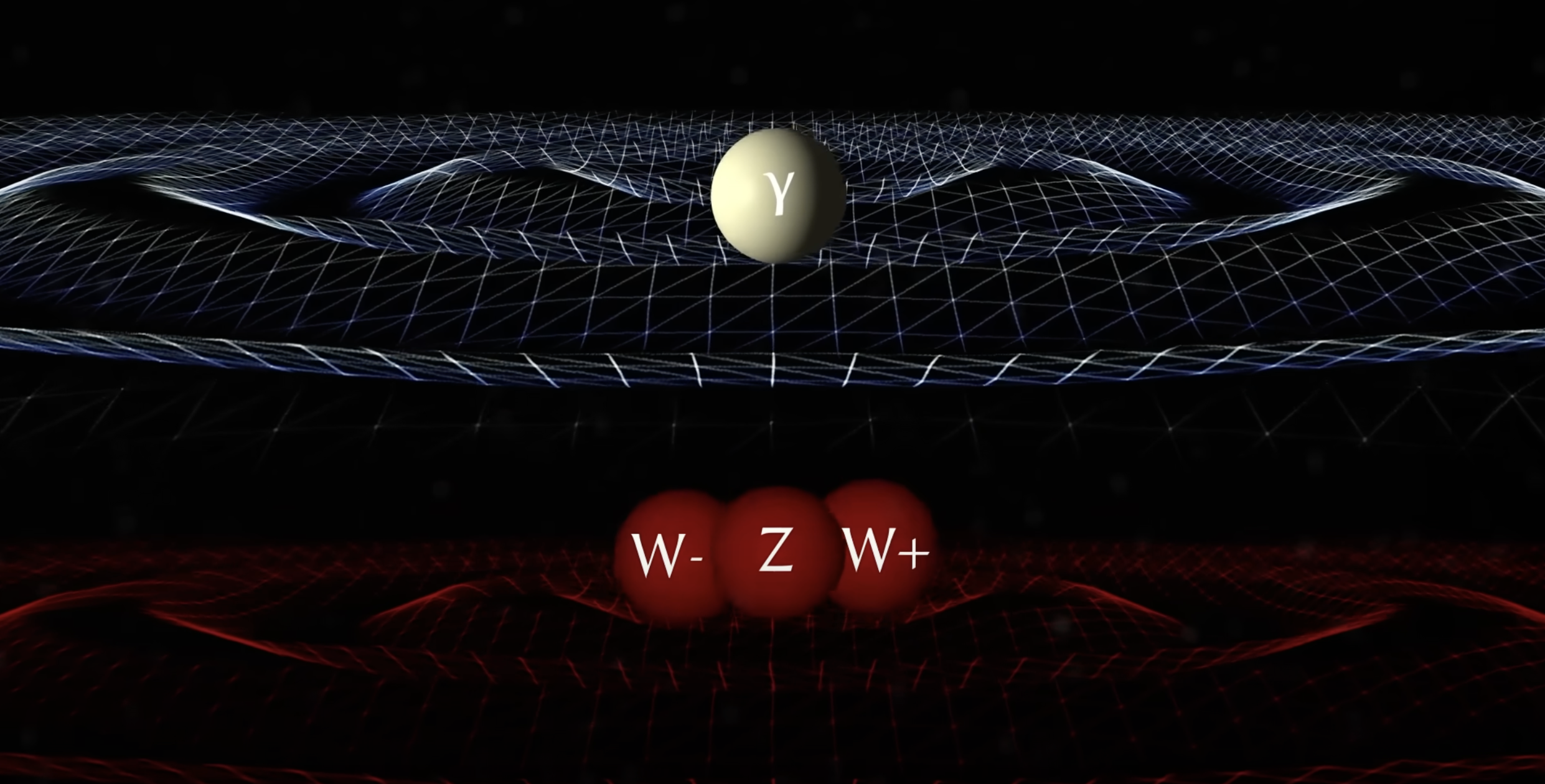
The Electroweak field is a theory that the electromagnetic and weak fields were once one single field in the very early stages of the universe - and they diverged into two separate fields with the expansion of spacetime.
The electroweak field was unified and massless so it allows the weak field to be treated as a normal quantum field with massless bosons - without the issues of the infinity problem.
So the question is how to go from one to two fields, and why does one of them have mass?
Finally we arrive at the point of this post.
The Higgs Mechanism
This is a visual simplification of what how the Higgs field operates on the electroweak field.
Firstly, we start with the Electroweak Field - assumed to have four massless bosons - b, W1, W2, W3.
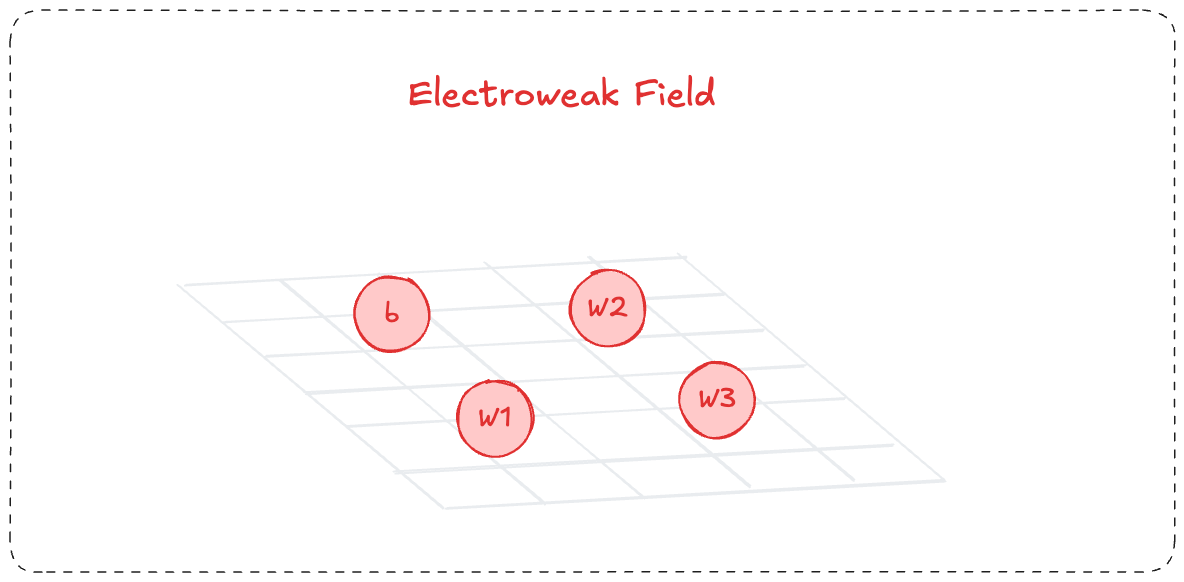
Another field also needs to have existed, which we will call the “H field”. This field is initially dormant, but spontaneously activates, bringing it’s own four bosons into play - H+, H-, H0, h

The activation of the new field breaks the symmetry of the electroweak field, forcing it to separate into the electromagnetic and weak fields.
- H+ combines with W1 to form the W+ boson
- H- combines with W2 to form the W- boson
- H0 combines with W3 to form the Z boson
- h doesn’t interact with b, allowing it to remain massless as the γ (photon)
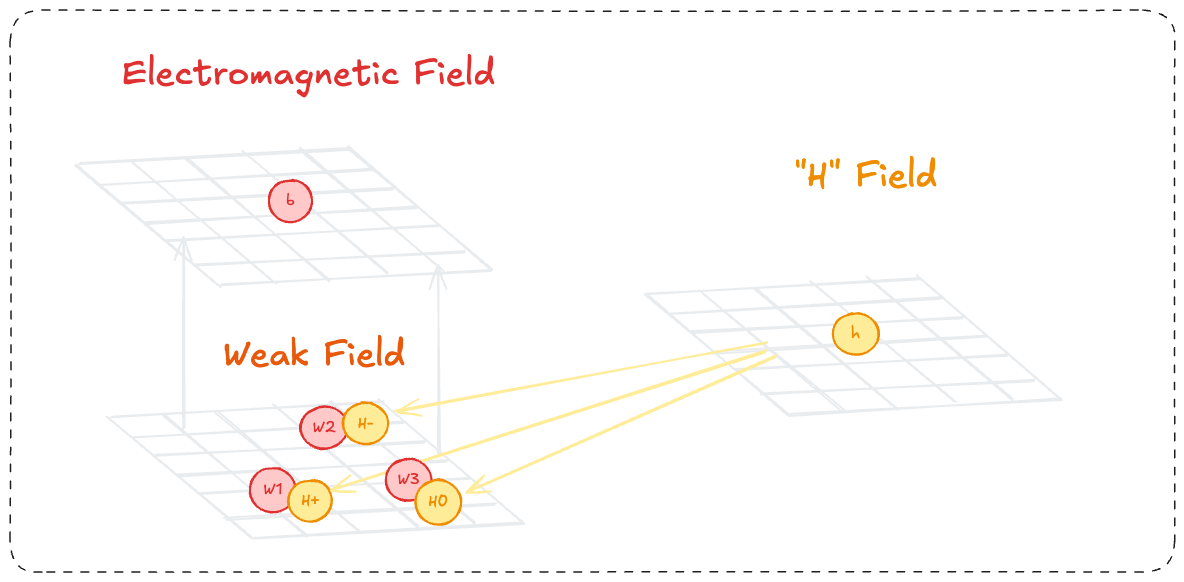
This results in three distinct fields - The electromagnetic, weak, and Higgs fields - what we see today.
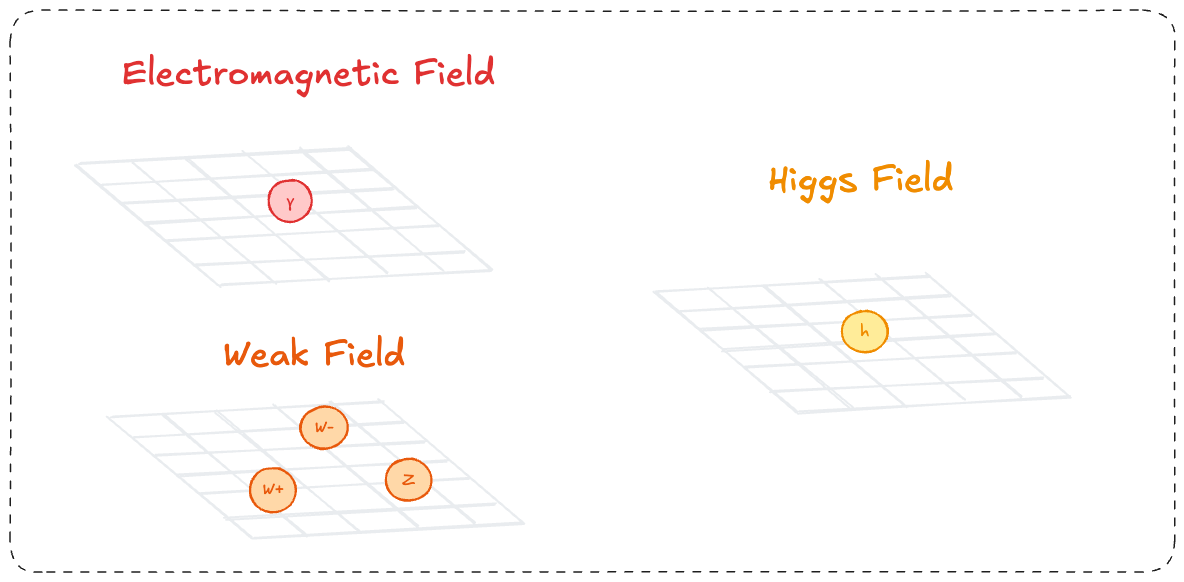
This theory, known as Quantum Flavor-Dynamics is important for 2 reasons:
- It can explain why certain bosons have mass
- It suggests the existence of the leftover boson - h - which survived this convoluted process.
h is the higgs boson - a theoretical leftover particle that could explain mass itself through it’s symmetry breaking property on the electroweak field. Well, it was theoretical - after a 40 year search at CERN it was discovered experimentally in 2012.
We no longer need a separate theory to explain the electromagnetic and weak fields, much like how we don’t need a separate theory for the electric and magnetic fields after their unification.
Spontaneous Symmetry Breaking
I glazed over an important detail earlier - what about the higgs field causes this break in symmetry that separates the electroweak field?
The “Sombrero Potential”
The higgs field, unlike any other field, contains an unusual potential shape.
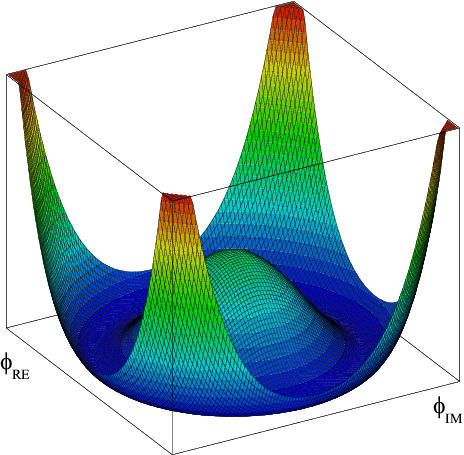
This shape has a peak in the center, implying that the higgs field is in it’s lowest energy state when it is non-zero. It naturally finds itself somewhere in the trough surrounding the peak.
This non-zero value is what breaks the symmetry in the electroweak field, and is referred to as the Vacuum Expectation Value of the higgs field, or VEV.
Rainbow Analogy
This realm is pretty hard to imagine, such that even the best analogies don’t really work that well.
The most famous is imagining light is a vacuum - where all wavelengths travel at the same length. In some substances, such as a glass prism, this symmetry is broken and the different wavelengths have different velocities, splitting the light into a rainbow of different colors.

The higgs mechanism operates in a similar way - it splits underlying fields into different asymmetries - giving some bosons mass, and not interacting with others at all.
Syrup Analogy
Imagine the universe is full of syrup - this is the higgs field at every point in space. Some particles feel the syrup, others don’t.
The extent at which a certain particle interacts (or “couples”) to the higgs field determines how much the are “dragged” back by the “syrup”.
This resistance to acceleration is known as mass.
This analogy is more intuitive, but incorrect, as the higgs field doesn’t apply any “resistance” to particles. Mass is an emergent property of the interaction energy. (Remember, energy and mass have an equivalence).
The Higgs Boson is one of the most important recent discoveries in physics, as it explains how the origin of mass for fundamental particles.
Without the higgs field - The Standard Model predicts that all particles would need to be massless, which is not what we observe.
But with it, it completes the standard model as one of the most accurate theories of reality ever created.